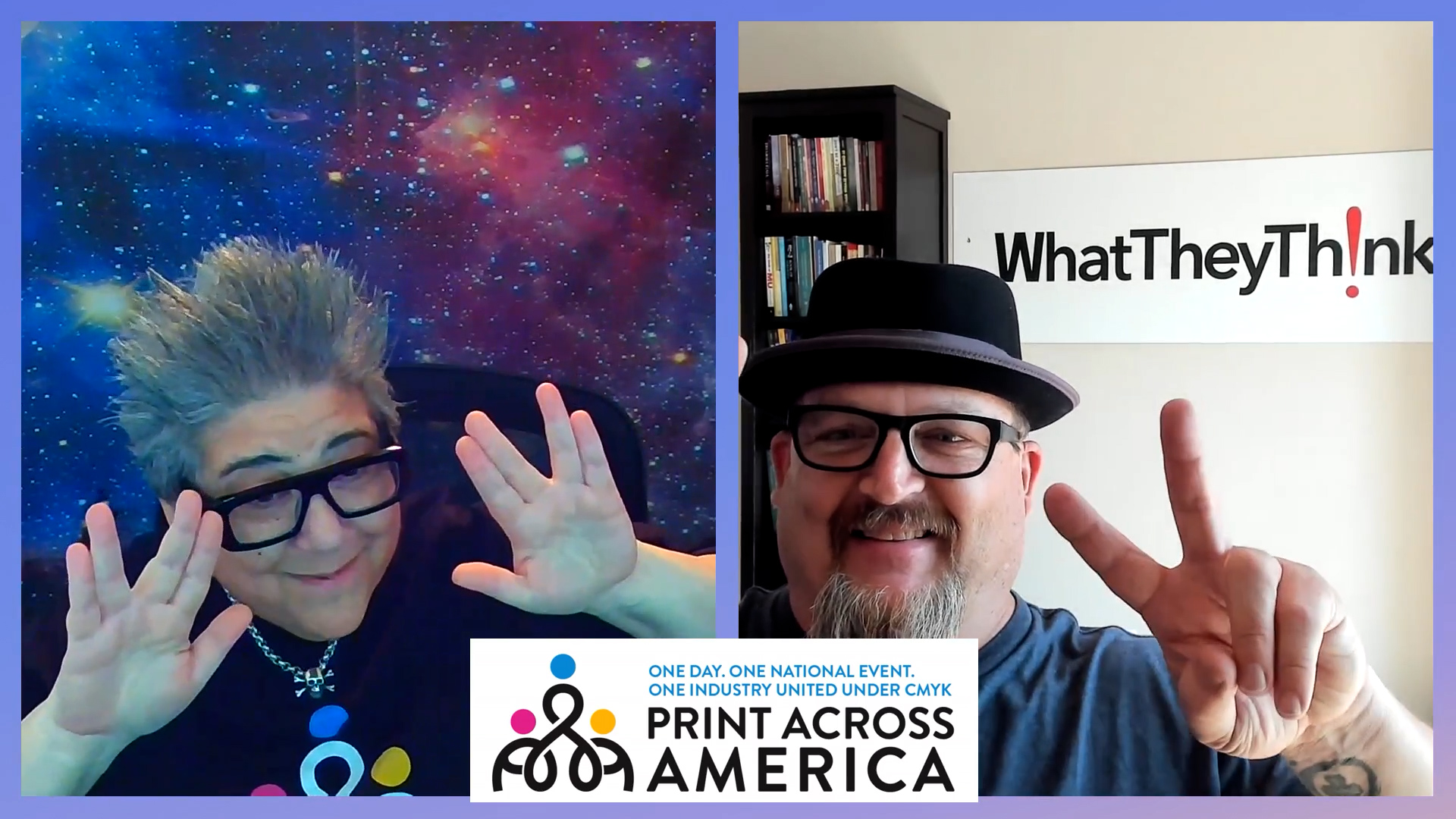White Papers and Special Reports
Digital Signage in the Print World
An innovative way to add greater value to your existing print offerings. This new white paper takes a look at how print and sign businesses can add digital signage solutions to their product and service offerings to complement and supplement their traditional offerings.
On Modernizing Variable Data Printing
Modern VDP enabled refined, unconstrained, and creative variability, which was a revolutionary break away from the existing VDP practice at the time. Combined with on-line access to data and scripting, it enabled print to work, together with digital, in the spaces of Marketing Automation and Customer Experience Management (CXM), both large and fast-growing markets. Implementing Modern VDP emerged as a major challenge, and the paper covers in detail the major obstacles and the innovations required for overcoming them. Jacob Aizikowitz, founder and past leader of XMPie, discusses Modern VDP and its impact on print.
On Your Green Guard - Understanding Environmental Certifications for Wall Décor Applications
Published October 2021 - Sponsored by Canon Solutions America
One of the hottest growth markets for digitally printed display graphics has been wallcoverings and décor, especially “environmental graphics” for offices, healthcare facilities, schools, etc. As we recover from the pandemic, and offices and other locations reopen, décor will only become more important. Print service providers looking to tap into this market must understand environmental issues—not just overall sustainability but health and safety requirements for materials used in décor.
To that end, various classification and certification programs have emerged to confirm not only the “greenness” of the assorted components of print production processes but also their compliance with health and safety requirements and regulations. But what do these certifications mean? Who confers them, and are they certifying truly sustainable materials?
BEYOND THE PRINT ENGINE: WHAT IS PRODUCTIVITY?
Published October 2021 - Sponsored by Canon Solutions America
A new WhatTheyThink white paper, sponsored by Canon Solutions America, looks at the various aspects of flatbed wide-format productivity, specifically focusing on board loading. Automation options, such as robotics, have started to appear.
5 KEYS TO A SUCCESSFUL PRINT ERP/MIS IMPLEMENTATION
Published September 2021 - Sponsored by Sabre
In this white paper, we offer 5 Keys to a Successful Print ERP/MIS Implementation that are critical whether you are implementing a solution for the first time or are looking to modernize an existing implementation. As part of the research for this white paper, we spoke to four leading companies who have successfully gone through this process and are willing to share their experiences.
Inkjet or Toner? New Decision Guide from Xeikon and Inkjet Insight Can Help
Published April 2021 - Sponsored by Xeikon
A digital press is no small investment, and deciding which is the right one can be tough for any print service provider. Much has been written on inkjet technology, and the same can be said for toner-based presses. But the same cannot be said for comparisons between the two technologies, which is arguably the most fundamental choice to ponder when considering this major purchase.
Full Speed Ahead: How to make variable data PDF files that won't slow your digital press
Published May 2020 - Second edition published January 2021
An independent guide providing objective information and advice to anyone with a stake in VDP: graphic designers, print buyers, production managers, press operators, owners of PSPs, and developers of digital presses and composition tools. The guide was edited by Martin Bailey, chief technology officer for Global Graphics and the primary UK expert to the ISO committees that maintain and develop PDF and PDF/VT. A number of leading vendors and supporters in the VDP sector have sponsored the guide, including HP Indigo, WhatTheyThink!, Digimarc, Delphax Solutions, Racami, Kodak, HYBRID Software and HP PageWide Industrial.
Breaking Bottlenecks: Using the Kodak Workflow Process Assessment to Recognize Opportunity in Your Workflow
Published April 2018
This white paper discusses the importance of workflow assessments as a cycle, rather than a standalone process. Furthermore, it will demonstrate how the Kodak Workflow Process Assessment (WPA) achieves this and therefore serves as a differentiator for printing companies.
Enhancing Label Production with Smart Workflow Automation
Published September 2017
Brand owners are increasingly focused on the role of product packaging in ensuring an engaging customer experience. At the same time, consumers expect responsiveness from their favorite brands, and when brands are not responsive to trends and concerns – often reflected in packaging – they will even abandon those brands.
For label and packaging converters, who have already been facing demand for faster turn times, cost-effective production of shorter runs, a growing number of SKUs and a requirement for strict regulatory compliance, these dynamics add even more complexity to an already complex and demanding production process. Label and packaging converters can expect to see even more pressure on cycle times from their brand owner customers. That being said, they play a critical role in enabling brands to achieve the level of responsiveness their end customers expect. To effectively serve in that role, an increased focus must be placed on operational efficiency and smart workflow automation.
Market Opportunities for Wideformat Digital Printing
Published April 2017
Digital printing continues to grow significantly, transforming the packaging, signage and display supply chain.
Web to Print: The Next Generation
Published April 2017
The next generation of web-to-print is here. This white paper makes a strong case for taking web-to-print offerings to the next level as customer requirements have continued to evolve, especially as cloud-based solutions and mobile communications have become ubiquitous and bandwidth is more readily available.
Success cases featuring online print provider Helloprint, direct marketing agency SK+G and provider of die-cut products Blanks USA clearly demonstrate the value of creating a pure play cloud-based clean sheet design that is not dependent on legacy technologies.
Top 5 Things to Automate in a Packaging Workflow
Published February 2017
As demand for smaller, often versioned lots and faster time to market continues to grow, brand owners, agencies and packaging converters alike are looking for ways to take time and touches out of the packaging workflow. They are interested in increased automation and solutions that improve the quality of the packaging while keeping costs in line. This latest WhatTheyThink white paper, sponsored by Kodak, discusses the Top 5 ways that packaging workflow can be automated to make the process as streamlined and cost-effective as possible without any compromise in quality.
A Case Study of Patent Abuse: Printing Industry Faces New Nemesis Impacting Growth and Employment
Published August 2016
At a time when the printing industry is searching for new growth and development opportunities, it now faces new obstacles: patent trolls, the epitome of greed, thoughtlessness, and unethical behavior impacting the survival of companies and jobs. This whitepaper documents recent litigation campaigns targeting printing companies and strategies for dealing with patent trolls.
Transforming Today's Print Business for Tomorrow's Marketplace - The View From 2020
Published January 2016
The market for print and for specific printed products has been changing dramatically. By 2020, the marketplace will have changed even more. As an industry, we cannot remain focused on "the way things have always been done." Printers need to rethink their businesses, and the products and services they produce. A lot of that involves rethinking the approach to buying equipment, as well as rethinking the entire company culture. This white paper looks at the changing role of print, the changing demand for print products, and how new tech- nologies are both challenging and enabling the print businesses of tomorrow.
Digital Finishing: The Last Mile
Published August 2015
This white paper discusses the impact of the digital revolution on the bindery and converting. It includes real-world examples of how printers and packaging converters are turning to digital processes to remove the bottlenecks from that "Last Mile" for a more efficient overall workflow that addresses the key market challenges, and for new and exciting capabilities that unleash designer creativity by taking off the handcuffs that have historically constrained them.
The Changing Face of Packaging: Brand Owners-and Printers-Respond to New Consumer Behaviors
Published July 2015
The past several years have seen wholesale changes in consumer behavior, which have taken place concurrently with the adoption of digital printing and the proliferation of brand communication channels. Consumers' relationships with brands, and thus with packaging, have also been transformed, and brand owners have had to adapt. What do these trends mean for print service providers, and how can print service providers take advantage of them?
Strategic Partnerships Help Commercial Printers Transition to New Markets
Published November 2014
Commercial printers are increasingly seeing new business opportunities in high-growth applications such as labels and packaging, sign and display, and other types of specialty printing. But transitioning to those kinds of printing applications presents numerous challenges, from understanding the hardware, software, and production requirements to the dynamics of unfamiliar markets. Hardware and software vendors like Esko are uniquely positioned to offer printing companies guidance in expanding in these new directions.
Precision Marketing: Print + Data = Results
Published September 2014
Achieving a Return on Marketing Investment (ROMI) is more critical than ever before as marketers embrace an omni-channel customer experience, integrating a variety of channels with real-time analytics. Precision Marketing techniques can deliver ROMI beyond expectations—even double-digit response rates. This white paper, sponsored by Ricoh Europe, introduces the concept of Precision Marketing, includes “Case In Point” examples of the results it delivers, and demonstrates how Big Data doesn’t have to be “big” to be effective—small and mid-sized businesses can benefit as well.
Color Your Mergers and Acquisitions Successful
Published August 2014
As the printing industry continues down the consolidation path, many companies are choosing to merge, acquire or be acquired in order to bolster their market strength. There are many challenges associated with consolidating companies. Deals often look great on paper but unless proper attention is paid to the integration process, the results can be disastrous. This white paper takes a look at some of the factors that cause mergers and acquisitions to be successful – or fail, and identifies some aspects of printing company mergers and acquisitions [M&A] that are often overlooked in the integration process.
5 Key Trends for Packaging Prepress and Production Workflow
Published June 2014
This white paper discusses how industry drivers and megatrends create a challenging context in which packaging service providers and printers are under constant pressure to change. In such an environment, print production workflow solutions address the challenges by focusing on five key directions
Trends and New Applications for Digital Communications Part 2
Published June 2014
Looking for more information on digital printing? This white paper will provide an overview of "high-value" applications enabled by the latest digital printing systems. Part 2 of this white paper focuses on the Kodak NexPress.
Solutions That Stick: The Basics of Using Magnetic Substrates
Looking for more information on magnetic substrates? This white paper will provide an overview of the technology, the options, and the applications for printing on magnetic and magnetizable materials.
Trends and New Applications for Digital Communications
Published March 2014
Looking for more information on digital printing? This white paper will provide an overview of “high-value” applications enabled by the latest digital printing systems. Please complete the brief form below to download this report.
Strong Press, Strong Heartbeat - Protecting Your Production Assets
Published November 2013
For any business, taking the appropriate steps to protect its investments is critical. For a commercial printing company, its offset presses are the heartbeat of the operation and a significant investment. This white paper describes best practices for maintaining a heart healthy press environment and includes real-world stories from a folding carton converter and a commercial printer that validate the importance of a vendor partner who is willing to go the extra mile.
Acquiring, Selling and Maintaining an Exceptional Customer Web Experience
Published November 2013
This web-to-print primer provides real-world advice and guidance on all things web-to-print, from selecting the right solution for your business to selling, maintaining and growing your web presence and the products and services you offer. It also includes real-world experiences that demonstrate the value of establishing and maintaining an exceptional customer web experience, and points to additional resources that will help you in making this journey.
Book Dynamics: Understanding a Changing Market
Published August 2013
Like many print segments in a world rapidly going digital, the book market has undergone tremendous upheaval over the past few years. Book publishers struggle to deal with declining sales of printed books across most categories while they continue to refine their e-book strategies. Book printers are looking for ways to more quickly and profitably produce shorter runs of books-either on demand to fill a specific order, or in a print-on-demand model with runs of 50 to 1,000+ units to reduce inventory costs.
This white paper presents a look at the current state of the book market along with a discussion of how technology can be applied to meet the challenges facing both book publishers and book printers. It features tips and techniques for profitably producing printed books in runs as short as one that will be helpful to both printers and publishers as they plan the future of their businesses.
Production Inkjet: Making the Right Choice
Published September 2013
With a growing number of production inkjet presses on the market using a variety of technologies and inks, it has become a more complex investment decision-making process for print service providers wishing to enter the production inkjet market. This white paper will discuss the various technologies, including their pros and cons, and offer questions the potential investors can ask themselves to help them make a better investment decision.
Going Wide Understanding the Opportunities in Wide-Format Printing
Published August 2013
Looking for more information on wide-format printing? This white paper will look at the overall market for wide-format printing, provide a technology overview, and offer some tips and advice for pricing, selling, and marketing wide-format printing. Please complete the brief form below to download this report.
Get Smart: Working Hard is Hardly Working for Shops Looking to Maximize Productivity
Published September 2012
Workflow automation has the potential to help both print providers and print buyers boost productivity and save money, and yet it is one of the most under-utilized software category today.
Welcome to the Machine: How and Why Workflow Automation Is Nothing to Fear
Published June 2012
Looking for more information on workflow automation? This white paper will explode come common myths and fears. Please complete the brief form below to download this report.
Shining a Light on Lightweight Papers: A Digital Printing Breakthrough
Published October 2012
We've all seen them: Bibles, directories, prospectus documents and other publications printed on paper so thin you can almost see through it. And those pharmaceutical inserts that seem to be folded a gazillion times before they are inserted into tiny boxes. These printed products have typically been produced in long runs using conventional offset printing, bucking the trend of shorter runs with more customized content. Why? Because paper that thin simply can't be run through a digital press, especially a sheetfed digital press...until now.
This white paper discusses how revolutionary technology in both web --- and sheetfed digital presses has brought lightweight papers and the applications that require them into the realm of digital printing, while at the same time opening the door to new applications and cost savings on existing applications.
Ensuring Safety and Quality with Low Migration Ink
Published July 2012
Looking for more information on package printing for food and other sensitive contents? Then this is the white paper for you.
- Innovations in Inkjet for Textile Production – live webinar
- Buying Inkjet Part 1: Does This Printer Make Me Look Good?
- LabelExpo 2023: Launches and Trends – Part 2
- Driving profitability with cut-sheet inkjet
- Zero Trust Environments for Inkjet Printing
- Kevin Roman on the evolution of professional services needs
- LabelExpo 2023: Launches and Trends – Part 1
- Inkjet Gets into “Hard Core” Applications
© 2023 WhatTheyThink. All Rights Reserved.








